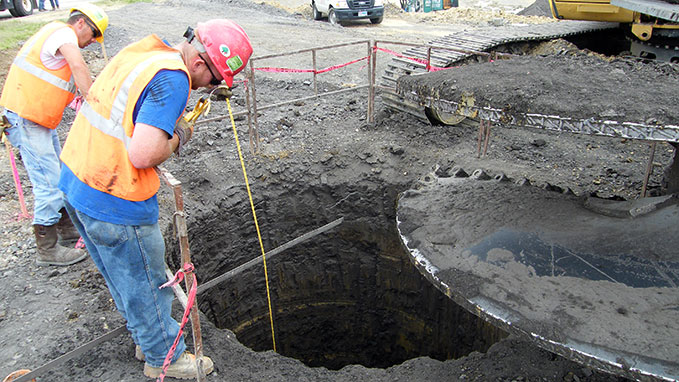Shaft Excavation
The Inspector has a variety of functions to perform during the shaft excavation process. From verifying the shaft is located in the proper place to verifying the shaft meets the cleanliness requirements upon completion of excavation, the Inspector needs to document construction events.
Shaft Location and Alignment
- Is the shaft being located at the correct plan location indicated on the plans?
- Typically there will be a plan tolerance which the Contractor must achieve.
- Is the kelly bar plumb? This is critical as there are tolerances for axial alignment that the Contractor must achieve.
Excavation
If the Drilled Shaft Plan specified the use of casing and or slurry, the Inspector must verify and document its use.
On many projects, a “surface casing” will be temporarily installed to stabilize the surface soils during the construction process. The constant in and out of the hole with drilling tools can quickly degrade the surface soils conditions if not protected.
The Inspector needs to be concerned with, in general, the following.
- Documenting the type of drilling tool and its diameter, and condition. Also remember to record its length, as the Inspector needs this to add to the kelly bar to determine depths.
- Documenting the length, diameter and type of any casing used.
- If slurry is used, verifying and documenting that the required sampling and testing is performed.
- Maintaining, in the required format, a log of the material excavated. Typically, there will be forms for Rock Coring, Soil/Rock Excavation and possibly others.
- Document, Document, Document. Job site photographs are a very valuable form of documentation.
Slurry Testing
Slurry needs to be maintained properly, as discussed earlier in, if it is to be effective. Typically, the specifications for a project will specify the type and number of tests to be performed on the slurry. The most common tests are:
- Viscosity- also know as Marsh Funnel Test, is the test used to measure the flow rate or consistency of slurry.
- Mud Balance Test- also known as the Mud Density Test, is used to measure the density of the slurry.
- pH Test- used to determine the alkalinity and acidity of the slurry.
- Sand Content Test- used to determine the sand content of the slurry. Generally the specifications have a maximum allowable percentage of sand permitted.
The lower cap is lower to the desired depth and the tube then lower on the cable to that depth. The top cap is allowed to slide down thereby trapping slurry at the sample depth.
Shown here is the sand washed and collected from slurry at the final step of the Sand Content Test. The percentage of sand is read from the graduated glass vial.
Shaft Cleaning
Depth Verification and Cleaning
During shaft excavation, the Inspector estimates the bottom of shaft depth by noting the depth marks on the kelly and adding the length of the particular tool to it, the sum of which provides the total depth. Upon achieving the desired shaft tip elevation and following cleaning of the shaft bottom, the Inspector needs to verify the depth and cleanliness.
Generally, cleanliness requirements will be specified and are typically based upon the amount, or thickness, of sediment permitted on the bottom of the shaft.
In making this determination, the Inspector uses a weight tape and takes “soundings” at numerous locations (normally 5) around and in the center of the shaft. These are recorded on the specified form. This should be done as soon as possible, as the longer the hole is open, the greater the potential for problems.

